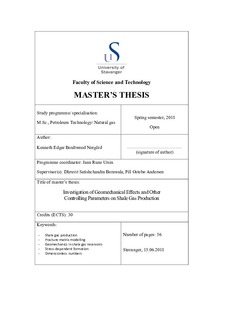| dc.description.abstract | Shale gas reservoirs are mainly characterized by their low matrix permeability, ranging from sub-nanodarcies to tens of microdarcies, which makes the economic production of these reservoirs rare without needing artificial stimulation. However, developments within two major technologies, horizontal drilling and hydraulic fracturing, have made the production more viable and shale gas reservoirs have attracted a lot of interest from around the world. Because of their abundance, shale gas reserves can provide part of the solution to the world’s growing energy demands. In conventional reservoirs, Darcy’s law is typically used to model the gas flow. However, gas flow in shale gas reservoirs is more complicated than in conventional reservoir because of many coupled processes such as gas adsorption and desorption, a large gas slippage effect (Klinkenberg effect), strong rock/fluid interactions and geomechanical effects. The impact on flow behaviour from these mechanisms is currently not well understood and although there are a few shale gas simulators available, they do not comprehensively involve all of these mechanisms.
In this thesis, an investigation of geomechanical effects and other controlling parameters for shale gas production is undertaken using a mathematical 1D+1D shale gas flow model. The model was provided by Berawala et al. (2018) and has been extended to include geomechanical effects. Geomechanical effects can be included into reservoir modelling by treating porosity and permeability of the formation is stress-dependent properties. Since the incorporation of geomechanical effects changed the scaling of the model, the new scaling approach has also been part of the thesis work. The model involves a high-permeable fracture extending from a well perforation through symmetrically surrounding shale matrix with low permeability. A sensitivity analysis is performed where geomechanical effects are varied in addition to varying other reservoir properties such as the fracture size, fracture shape, fracture spacing and initial reservoir pressure. Input parameters from literature data are applied. The simulation results are interpreted with and without using the dimensionless numbers 𝛼� and 𝛽�. The value of can express 𝛼�𝛽� the residence time of gas in the fracture compared to in the matrix. Therefore, if 𝛼�𝛽� ≪ 1 it is expected that fracture properties have little impact on gas recovery. | nb_NO |
